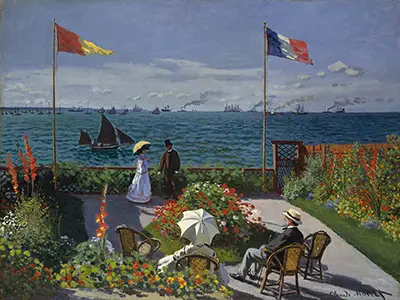It was painted when the artist was a young man, spending the summer with his family at Sainte-Adresse, a seaside resort on the Normandy coast of France.
As one of his earlier works it still retains some of the smooth lines and contours of the established style of the time, against which he and his fellow artists were rebelling. But even at this early stage in his career, he was developing a more natural style, with misty smoke trails disappearing into the clouds on the horizon, and gloriously vivid splurges of summer flowers.
The long shadows suggest Monet was painting the scene in the late afternoon, but the bright summer sun still shines through. The sunlight reflecting from the white surfaces in the foreground of the picture has an intense and brilliant luminescence. The man and woman sitting upright and formal with their backs to the viewer are thought to be Monet’s father and the wife of a more distant relative. The younger couple standing close to the water are also thought to be relatives, so that the scene appears to be one of a blissful family holiday, although at the time Monet was facing great uncertainty and his father disapproved of Camille Doncieux; Monet's companion who went on to become his wife.
By setting up his easel to work at a higher level, looking down on the garden and the sea beyond, Monet was able to paint the garden terrace, the sea and then the sky as three distinct bands. Monet's inspiration for this approach came from his informal teacher; Eugène Boudin, and also from his admiration of Japanese prints, which he collected. The print Turban-shell Hall of the Five-Hundred-Rakan Temple by Katsushika Hokusai may have directly influenced Monet’s use of this three tier framework, with its multiple perspectives.
In a similar style to the Japanese print, Monet created three horizontal zones in Garden at Sainte-Adresse, emphasising the two dimensional aspect of the painting. Indeed, Monet’s friend and fellow impressionist; Renoir, referred to the painting as “The Japanese one with little flags.” Monet then added his own unique impressionist flair into this broad, three band, structure, linking the red shades of the flags in the top band with the red flowers in the bottom band, and the particular blue at the top of the sky with the lilac blue hues at the base of the flower beds.
Monet exhibited this painting at an impressionist show in 1879 with the title it has today; Garden at Sainte-Adresse or in French; Jardin à Sainte-Adresse. But over the years it was known by a number of different names before being reunited with its original title when the catalogue for the 1879 exhibition came to light. Whatever its title it remains a remarkable and undimmed depiction of a summer holiday idyll.
Claude Monet (born 1840 in Paris, died 1926 in Giverny) became a supreme master of Impressionism; an art movement which he developed, along with other Paris based artists from the 1860s onwards. The impressionists, influenced by earlier artists such as the British painters John Constable and Joseph Mallord William Turner, endeavoured to capture the moment by working quickly in the open air (‘en plein air’) to give as true an impression as possible of the light and colour they saw as they painted.


